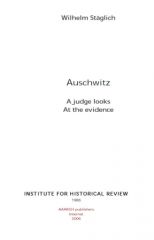
Author : Stäglich Wilhelm
Title : Auschwitz A judge looks at the evidence
Year : 1986
Link download : Staglich_Wilhelm_-_Auschwitz_A_judge_looks_at_the_evidence.zip
Foreword. “Auschwitz – it was Hell.” For all its subjectivity, this remark attributed to a former inmate does not begin to characterize the emotion-charged ideas the word Auschwitz evokes today. Auschwitz symbolizes more than the multitudinous agonies suffered in concentration camps, not only German camps during the war, but concentration camps everywhere, past and present: It has come to symbolize the “murder of millions of European Jews.” Everyone “knows” that we are not “supposed to” voice the slightest doubt regarding the legend that is Auschwitz, or even relate personal experiences that might not be entirely in line with it. Indeed, to commit such heresy is to run the risk of losing one's livelihood. For the powers that be have ordained that Auschwitz must be viewed in one way only. That is exactly what should make us leery. Truth does not require coercion to be accepted. Its persuasiveness does not depend on constant repetition of bold-faced claims. All that is really needed for truth to prevail is to show the facts, and let common sense do the rest. What then could be more natural than to examine the factual basis of the allegation that Auschwitz was the site of the most extensive and atrocious massacre of Jews in history? Almost everybody is familiar with this claim, but nobody can say just what evidence there is to support it. People have come to regard the whole subject as taboo. I noticed this was true even of the judges who imposed a relatively harsh penalty on me for having published, in the form of an open letter, a de visu account of the Auschwitz parent camp that conflicts with the now current picture of Auschwitz.* When I wrote that letter, it was far from my intention to dispute the extermination thesis per se. Anyway, that would have been outside the scope of my account. However, the reaction it provoked made me realize for the first time what importance the powers that have for decades been determining our destiny as a nation place on the Auschwitz taboo. That realization awakened in me an irresistible urge to research the historical sources for the allegation that Auschwitz was an “extermination camp,” and come to grips with it. I believe my findings deserve to be brought to the attention of the general public. At the outset, let one thing be noted: Contrary to popular belief, Auschwitz was not a single camp under central administration. Rather, it consisted of a number of individual camps of various sizes, some of which had considerable organizational autonomy. The actual Auschwitz camp —the socalled Stammlager (“parent camp” or “main camp,” also known as “Auschwitz I”)— was situated about 2 kilometers southwest of the town of Auschwitz in Upper Silesia. Not this camp, but the Birkenau camp, located about 3 kilometers west of the town, is supposed to have been the site of the extermination of the Jews. There was a series of other camps in the Auschwitz region, some of which had been established for special purposes, such as Raisko, for agricultural experiments, and Monowitz, for the production of synthetic rubber. All these camps were associated, more or less loosely, with the main camp. Thus it is hardly correct to designate “Auschwitz” as an “extermination camp,” pure and simple, as people often do, perhaps from ignorance. Basically, “Auschwitz” was a network of labour camps established in the industrial area of Upper Silesia for the German war economy. The Birkenau camp (“Auschwitz II”), which is the focal point of the extermination claims, served primarily as an internment camp for specific groups of prisoners, such as Gypsies, women with children, as well as the chronically ill and those who were otherwise incapable of labour. It also served as a transit camp and, initially, even as a prisoner of war camp. In the spring of 1943, several crematoria —allegedly containing “gas chambers” for the extermination of Jews— were put into operation there, while the original camp crematorium in “Auschwitz I” was shut down in July 1943. The real subject of our investigation is the charge that Birkenau was an “extermination camp.” This work is not intended to give a definitive picture of Auschwitz – something that would, in any case, be beyond the limited resources at my disposal. It also has no pretensions to being a Geschichtsschau in the Rankian sense, that is, an attempt to depict Auschwitz “as it really was.” Rather, it is an effort to survey, examine, and assess as objectively as possible the evidence that has thus far been presented for the claim that Auschwitz was a “death factory.” Unfortunately, the Institut für Zeitgeschichte (Institute for Contemporary History) in Munich has not seen fit to grant my request for its assistance. My correspondence with the institute is so revealing that I must share it with my readers (see Appendix III). Likewise, I was refused permission to examine relevant trial records (see Appendices IV and V), and therefore had to rely on published collections of trial documents, such as they exist. I am aware, of course, that Auschwitz is not the only camp that has been linked to the “extermination of the Jews.” Nevertheless, it assumes such importance in this connection, both qualitatively and quantitatively, that I am convinced that the extermination thesis stands or falls with the allegation that Auschwitz was a “death factory.” That alone should justify my restricting the scope of this inquiry. Finally, let it be noted that the present volume is the work not of a professional historian, but of a jurist with an interest in recent history. Naturally, I have tried to observe the rules of scholarship. My intention is not to polemicize, but to take stock of the evidence that has thus far been presented for the claim that Auschwitz was a “death factory,” as objectively as possible, and draw the logical conclusions from it. If certain passages in this work strike the reader as polemical, he would do well to ask himself whether such lapses are not unavoidable given the nature of the subject. Dr WILHELM STÄGLICH Hamburg, December 1978. ...

Demolins Edmond - Saint Louis
Auteur : Demolins Edmond Ouvrage : Saint Louis Année : 19881 Lien de téléchargement :...














